ISSN ONLINE(2319-8753)PRINT(2347-6710)
ISSN ONLINE(2319-8753)PRINT(2347-6710)
| Nasir Widha Setyanto, RembaYanuar Efranto, Rio Prasetyo Lukodono and Aisah Dirawidya Department of Industrial Engineering, University of Brawijaya, Malang, Indonesia |
| Related article at Pubmed, Scholar Google |
Visit for more related articles at International Journal of Innovative Research in Science, Engineering and Technology
Keywords |
| Ergonomics, MSDs,NIOSH, Nordic Body Map, OWAS |
INTRODUCTION |
| Musculoskeletal Disorder (MSDs) or a skeletal muscle disorder is an injury in muscles, nerves, tendons, ligaments, joints, cartilage, and discus intervertebralis. Muscles injuries can be in forms of muscle strain, inflammation, and degeneration. Meanwhile, bone injuries may be forms of bruising, micro fractures, fractures, or twisted bones. MSDs occurred in two ways, which are a constant fatigue and exhaustion caused by the frequency of long duration of muscular effort, and sudden injury caused by severe activities or unpredictable movements [1]. Anticipating MSDs becomes crucial in order to reduce workers’ exhaustion so that their health will be guaranteed, and also the company’s productivity could be increased, but the discussion will be limited to reduction of MSDs in workers. |
| In the finishing slab processes of steel, there are some processes such as cross transfer process, cooling bed, and scarfing process, the process which is done manually is scarfing [2]. During scarfing process, the operator is working with the position of standing and lifting scarfing machine with the weight up to 12 kilograms. Scarfing operator is a shift worker, who has working time up to 8 hours, each operator and shift has their own target completion [3]. Their working condition which requires them to bear on the position of head and back bending and also lifting the heavy machine during working time indicate that the working facilitates are not ergonomic. |
| Regarding this issue, this journal conducts an analysis of working posture by using Nordic Body Map method, OWAS and NIOSH. Nordic Body Map is a method done by analysis body map directed to each body part. Through Nordic Body Map we can see the parts of muscle which are undergoing complaints from the level of uncomfortable feeling (a bit painful) to the high level of pain [4]. OWAS is a method of working posture analysis by undertaking evaluation on working posture that causing musculoskeletal injury [5]. Meanwhile, NIOSH is an analysis method which is worthwhile for determining Recommended Weight Limit (RWL) and Lifting Index (LI). |
RESEARCH POSITION |
| A research entitled “Analisissikapkerjapekerja manual material handling UD TetapSemangatdenganMetode OWAS (An analysis on manual material handling workers’ working posture in UD TetapSemangat by using OWAS method)” conducted by Triyono (2006) was undertaken to identify and analyze working posture in order to know the present condition of working posture. The result of this research is the activities done in printing department and also in shipping department are still risky. The workers’ posture is bending and twisting when doing umbrellas organizing activity. The improvement is done by making the posture of back and hips is better in line and feet posture rests on both feet in the straight position [4]. The identification and improvement can be done by using OWAS method. |
| A research entitled “Analisis Manual Material Handling MenggunakanNiosh Equation (An Analysis on Manual Material Handling Using Niosh Equation)” by EtikaMuslimah (2006), the people being researched were the workers who lift rice bags, whereas the research location was warehouse “BULOG” Sub Depot Logistic Area III Surakarta PergudanganBeras 305 Grogol, Sukoharjo. The research was conducted by using calculation method of energy consumption and heart rate, RWL in NIOSH and Lifting Index (LI). Based on the calculation of energy consumption, it is seen that the energy consumed is included in light workload. Then, according to the calculation of Recommended Weight Limit (RWL), it is seen that lifting load in PergudanganBerasBulog is too heavy because the value of the calculation of RWL is between 8.87-10.7 kilograms, beyond under the actual lifting load value which is 40 kilograms and the result of the LI calculation causes spinal cord injuries since the value LI >1 [5]. |
| NatayaCharoonsri R, Dian Mardi S, and Fransiskus Alexander conducted a research “IdentifikasiRisikoErgonomipadaStasiunPerakitanDaunSirip Diffuser di PT. X” in 2008. This research is about identifying ergonomic risks in work station X Company. This identification is conducted since work station is classified as a light job but it is repeated and done in a long time. The result of this research is that work station 2 is indicated; especially in the process of assembling has the highest REBA value which is 11 and it is classified as a high level of risk. Meanwhile, based on Nordic Body Map questionnaire it is shown that the problems are mostly occurred in waist, the top of the neck, the right shoulder, and the top of the right and left arms. Based on the analysis on working method, it is found that cycle time 138.78 seconds with the imbalance between right and left arms. The left arm is in the idle or static state for 89.72 seconds [6]. |
| In this research, the method to identify whether there is any complaint toward MSDs in workers is conducted by giving Nordic Body Map questionnaires. The result of the questionnaire will show which workers’ body parts that are undergoing a complaint of MSDs [7]. To reduce the complaint of MSDs, the scarfing workers should improve for better posture, but since their posture is formed due to the working facilitates, the additional suggestion is not only for working posture but also working design as the supporter of the safe working posture. The suggestion for improvement in terms of working posture is based on the calculation of OWAS, whereas for working design is based on NIOSH method. |
RESEARCH METHOD |
| Field study or survey introduction is conducted to know the present condition in the field. Field study is done by spreading Nordic Body Map questionnaire and interviewing some workers in each shift.Literature review stage is done to study science theory about problem solving found in the next stage. This stage also can be done whenever during research process if the researcher needs another theory to support this research.The research questions are arranged after understanding the problems occurring and then formulate them according to the facts taken place in the field.The researcher uses two methods in the data collection. They are library research and field research. The stages of data collection using field research method are observation, interview, and documentation. Data collection needed in this research is complaints data based on nbm, operator’s working posture photos, the angles and the body size of workers during scarfing process, and scarfing machine data.In this part, the analysis of collected data in the previous step is done. Workers’ complaint data is as research basis. The operator’s working posture photos are analyzed by using OWAS method, and then the angle and the body size of workers are analyzed by using NIOSH.The results of posture data and working design analysis generate an ergonomic suggestion for improvement. The suggestion is that the calculation using OWAS and NIOSH should be verified.After all of the hypotheses based on analysis result are made, the conclusion of the research can be generated. |
RESULTS AND DISCUSSION |
| Scarfing process is a process of identifying and omitting any defect on the slab. The solution of the various slabs is based on the defect. The kinds of defect on the common slab is called scarfing code. The picture of scarfing workers can be seen in Figure 1. |
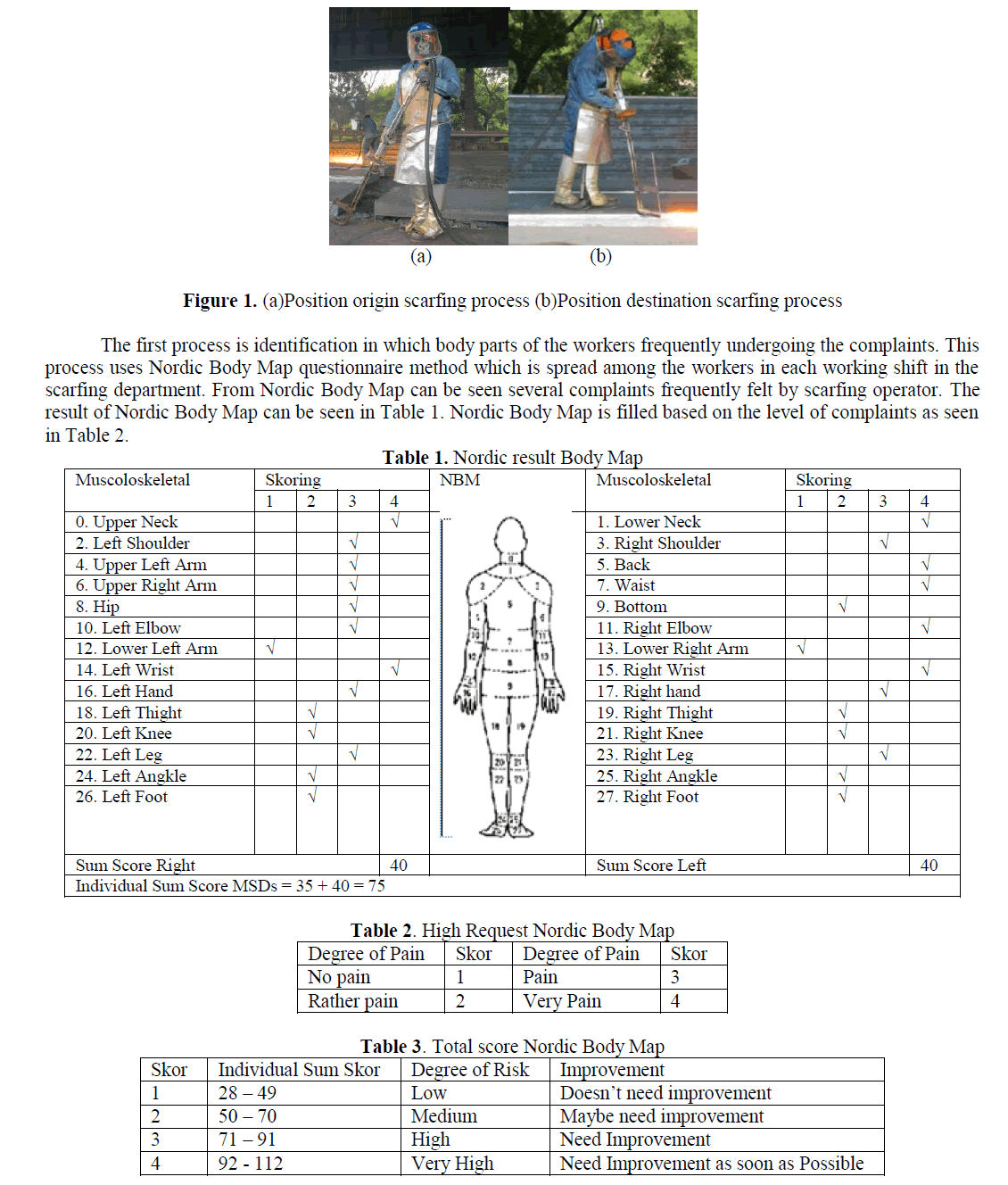 |
| Based on the result of nbm, the total score of individual with MSDs is obtained which is 75 meaning that immediate action as Table 3 is needed. It is because the scarfing workers’ posture is bending for a long time and walk slowly during scarfing so that the exhaustion mostly occurred in the top of neck, left wrist, right wrist, nape, back, waist, right elbow, and calf. The recommended improvement is in form of administration improvement where scarfer in training should be based on recommended working posture and condition so that the scarfer who passes the training about 6-12 months can surely have safe working posture. |
OWAS |
| To improve working posture and follow up the result of Nordic Body Map questionnaire, the calculation of OWAS is conducted. The calculation of working posture is done by using ErgoFellow software. The OWAS score filling is based on Figure 1, such as the bending worker’s back is scored 2. The result of OWAS calculation can be seen in Figure 2. |
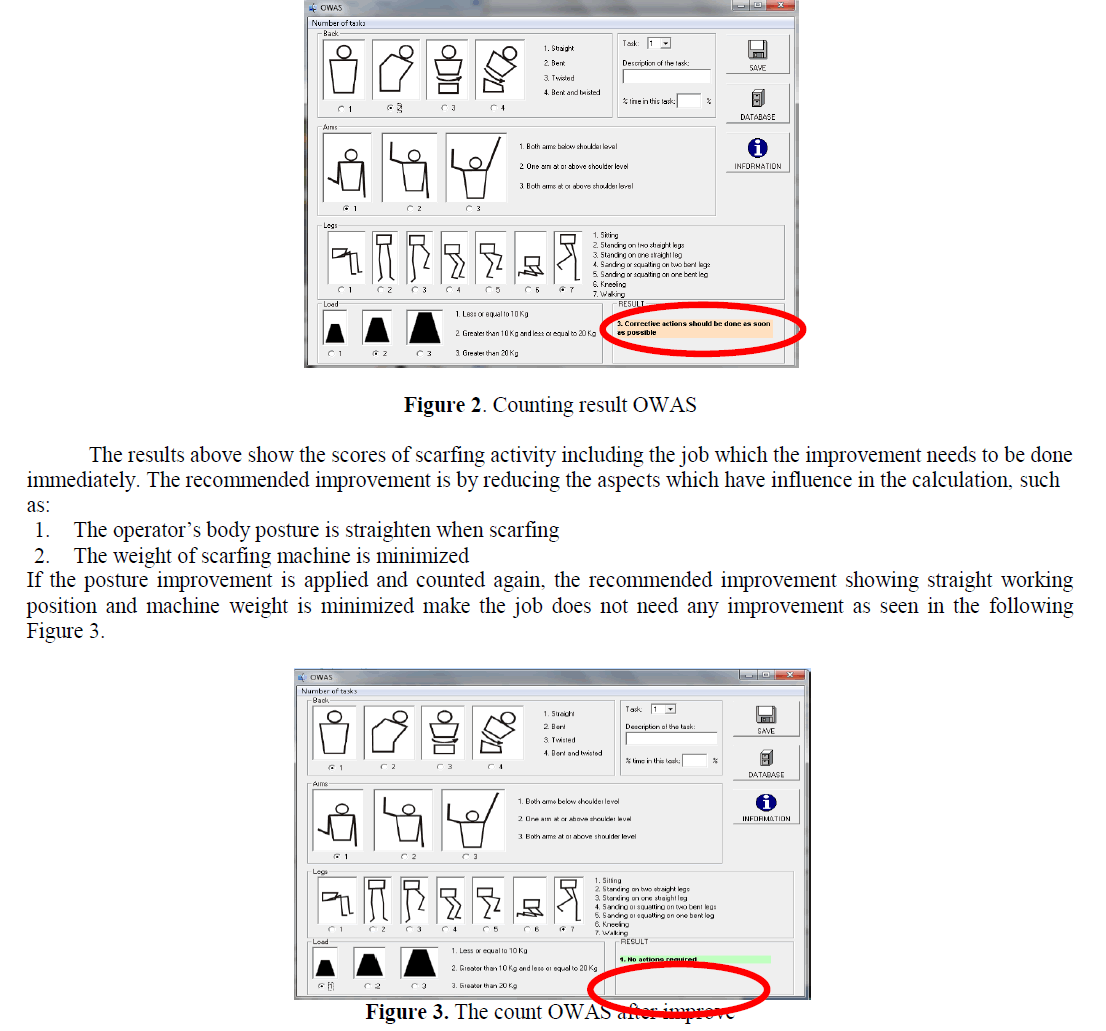 |
NIOSH |
| The calculation of NIOSH is based on one of OWAS results which stated that it needs to reduce the workers’ lifting load. The NIOSH size is similar to Figure 1 origin position and destination scarfing. The data of origin position and destination scarfing can be seen in Table 4 below. |
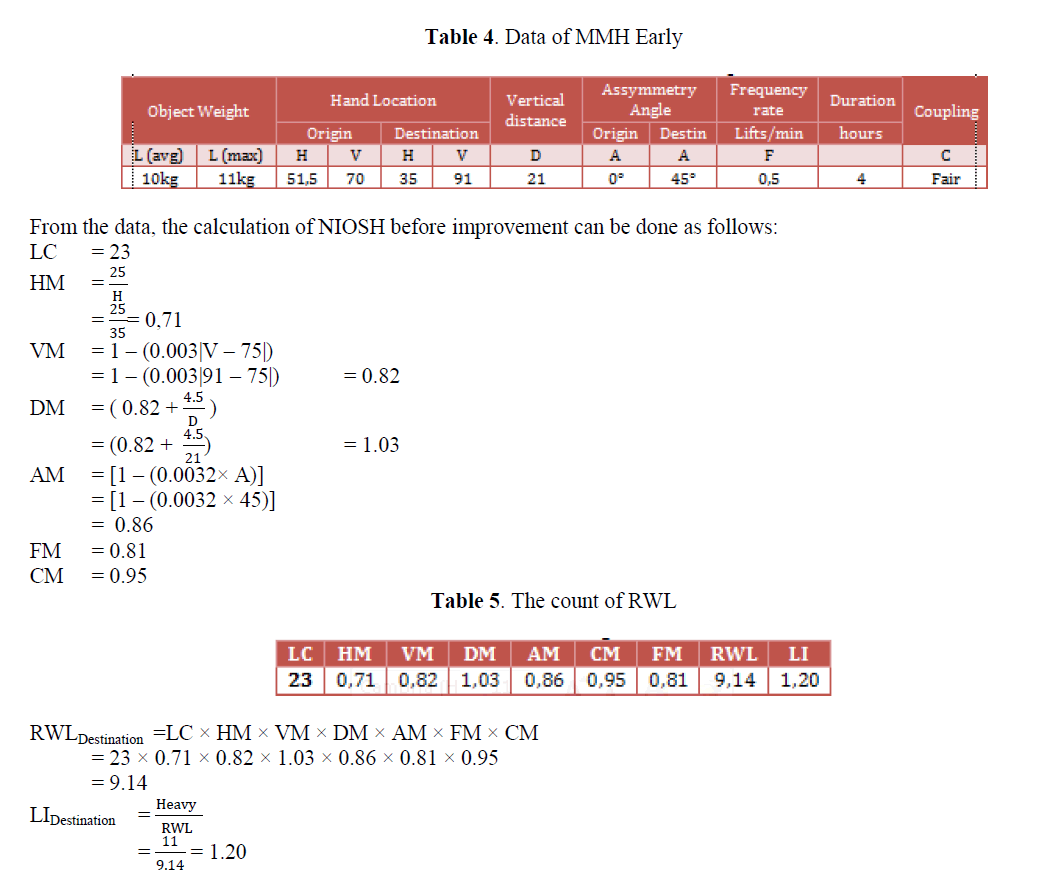 |
| Table 5 is the result of NIOSH calculation. Since LI >1, the lifting load activities is in the state of danger, the improvement toward the working condition is absolutely needed. The changeable working condition is reducing the distance of the object or handling with the workers’ body central, but since the blaner produces heat, if it is too close with the workers, so the handling distance with the blaner edge is extended. Working condition change can also be done by reducing vertical distance between the blaner and the workers. The reduction of worker’s asymmetry can also be done to reduce injury risk undergone by scarfer. Moreover, it can reduce vertical distance change gap and it can influence to reduce injury impact for workers. The improvement on coupling such as adding rubber and flexible in order to make the coupling used more comfortable because the blaner is used in a long duration and the flexible addition is done so that the height of the coupling can be adapted with the operator’s body height. If the proposed improvement is counted again, then it will change as Table 6. |
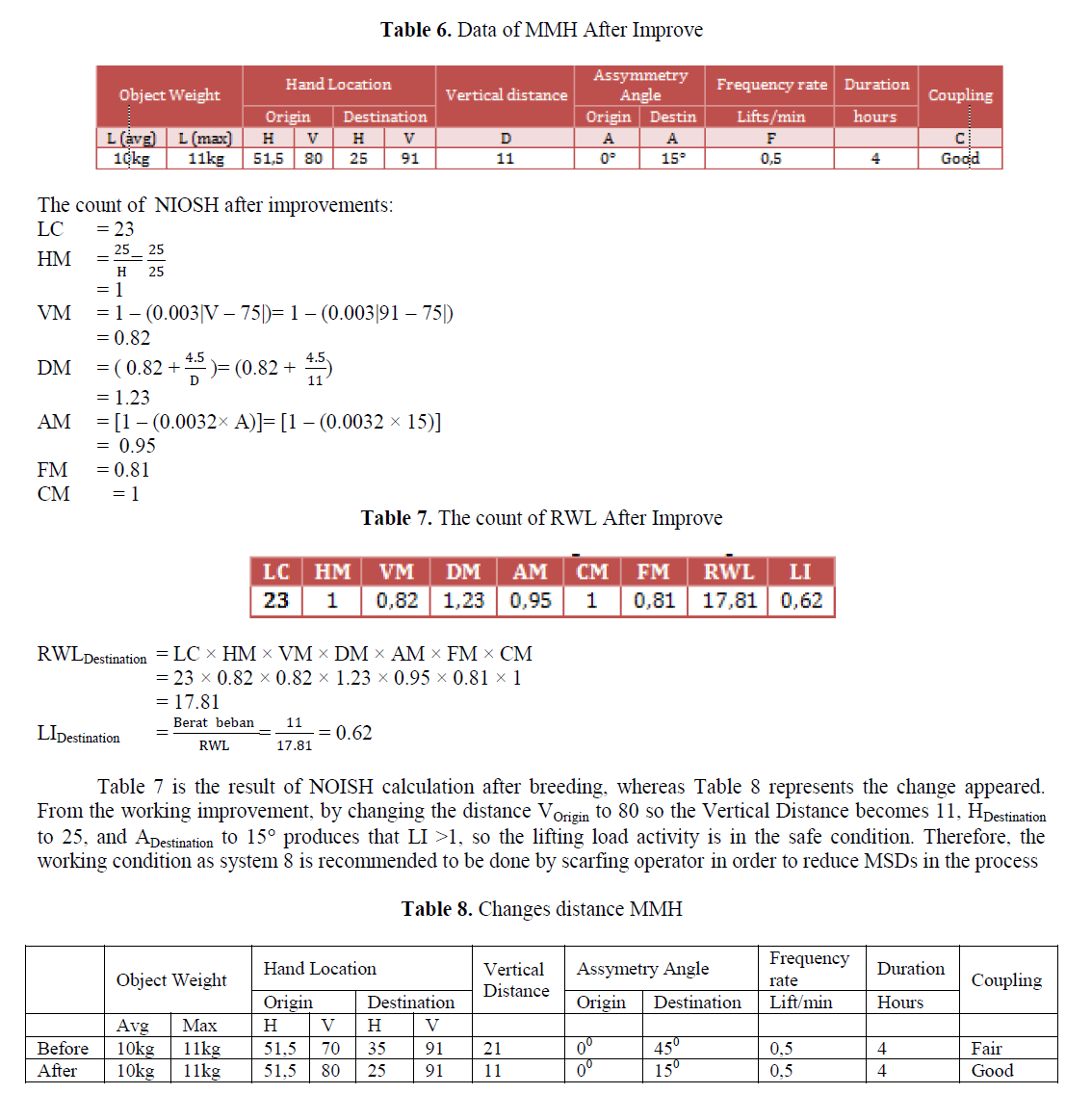 |
Suggestions for Improvements |
| Based on the whole research results and the improvement done in working system of lifting load activity, the recommendations are formulated as follows: |
| 1. The scarfer is recommended to be in upright position when scarfing |
| 2. The blaner weight lifted is minimized |
| 3. The recommended distance to do scarfing is 25 cm from coupling body central. |
| 4. The recommended distance when scarfing is 91 cm from coupling with slab stepped by scarfer. |
| 5. The angle of the worker’s asymmetry is not more than 15° |
| 6. Then the coupling should be covered by rubber because the workers use it for a long time and it will make it more comfortable. |
| 7. The coupling should be flexible, so that it can be moved up and down in accordance to the workers’ body weight. |
| 8. The training is done based on the improved working posture. The result of improvement recommendation as Table 9 is expected to be able to reduce MSDs in the result of Nordic Body Map calculation. |
CONCLUSION |
| According to the research conducted, it can be concluded that: |
| 1) The evaluation of scarfing operator working position in Slab Steel Plant (SSP) division are: |
| a) Using OWAS method shows that the improvement of scarfing workers’ body posture needs to be done immediately and as soon as possible since the scarfer’s body postures are bending back, hands down and lift 11 kg blaner while walking. |
| b) The evaluation of NIOSH method shows that the lift is in the dangerous category since the vertical and horizontal distance of scarfer mass central with the blaner or the distance gap before and after between scarfer mass central and slab is maximized. |
| c) Based on Nordic Body Map, the complaints undergone by scarfer are occurred in the top of the neck, nape, back, waist, shoulder, elbow, wrist, and calf. The three methods stated that the scarfing workers’ body position and posture are dangerous position and it needs to be improved immediately and as soon as possible. |
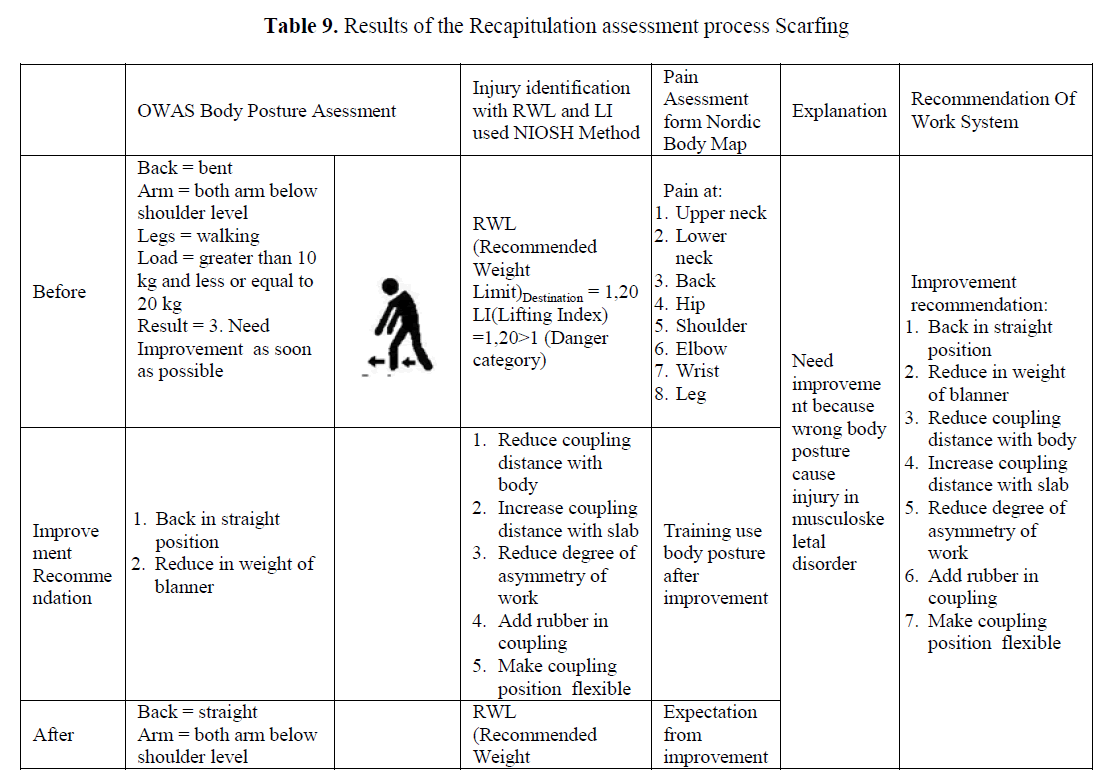 |
 |
| 2) The working system improvement is based on three methods such as OWAS, NIOSH, and Nordic Body Map: |
| a) By using OWAS method, scarfer’s back who are doing scarfing is suggested to be upright and the blaner weight should be reduced (less than 10 kg) |
| b) Improvement recommendation by using NIOSH is that recommended distance when scarfing is 25 cm from the body central to the coupling, 91 from the coupling to the slab stepped by the scarfer, the angle of the worker’s asymmetry is not more than 15°, and the coupling should be covered by rubber since the workers use it for a long time so that it will be more comfortable. Besides, the coupling is made very flexible so that the coupling can be moved up and down just like the workers’ body height. |
| c) Based on Nordic Body Map, the recommended improvement is administration improvement which the training done by scarfer is based on the recommended working postures. |
References |
|